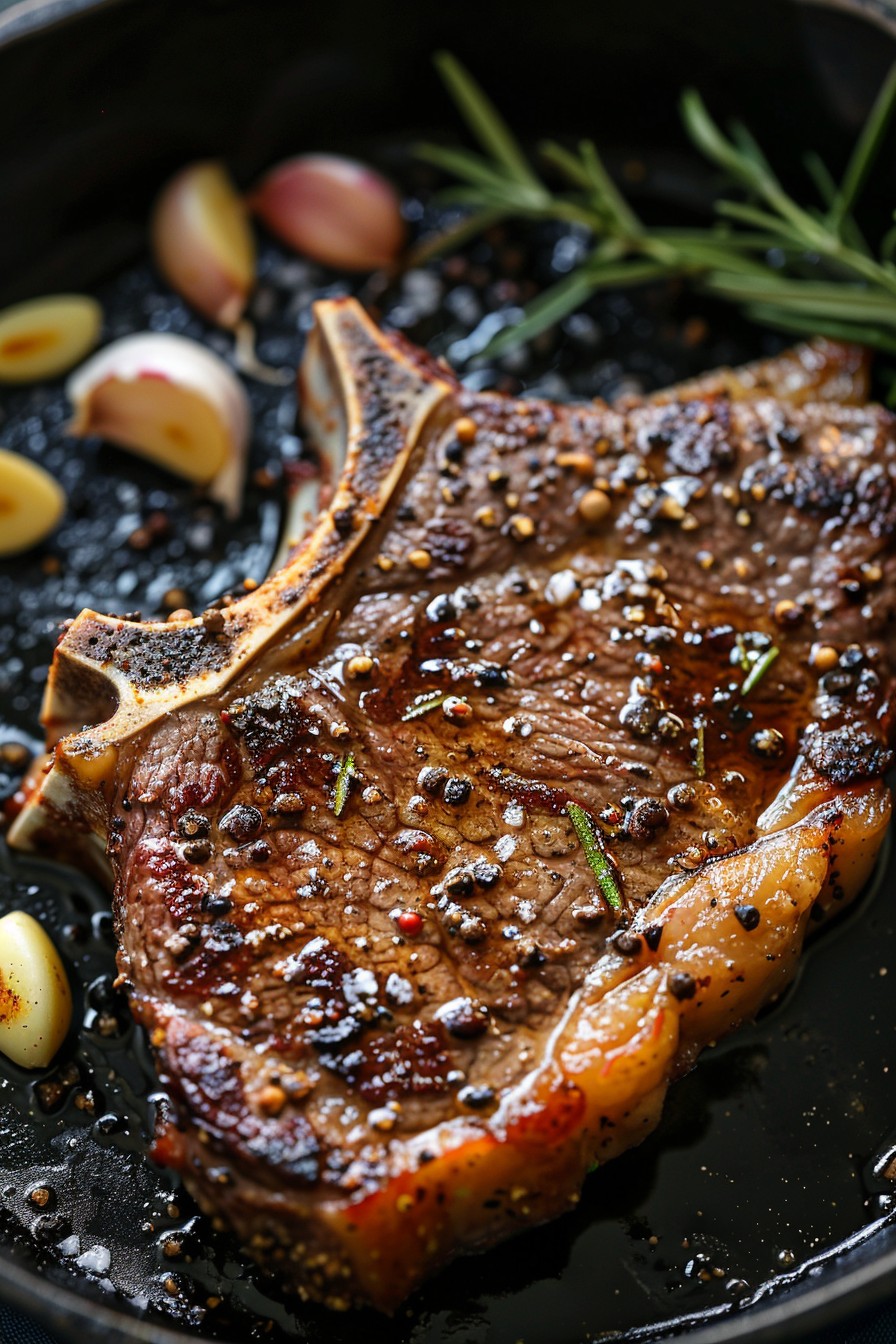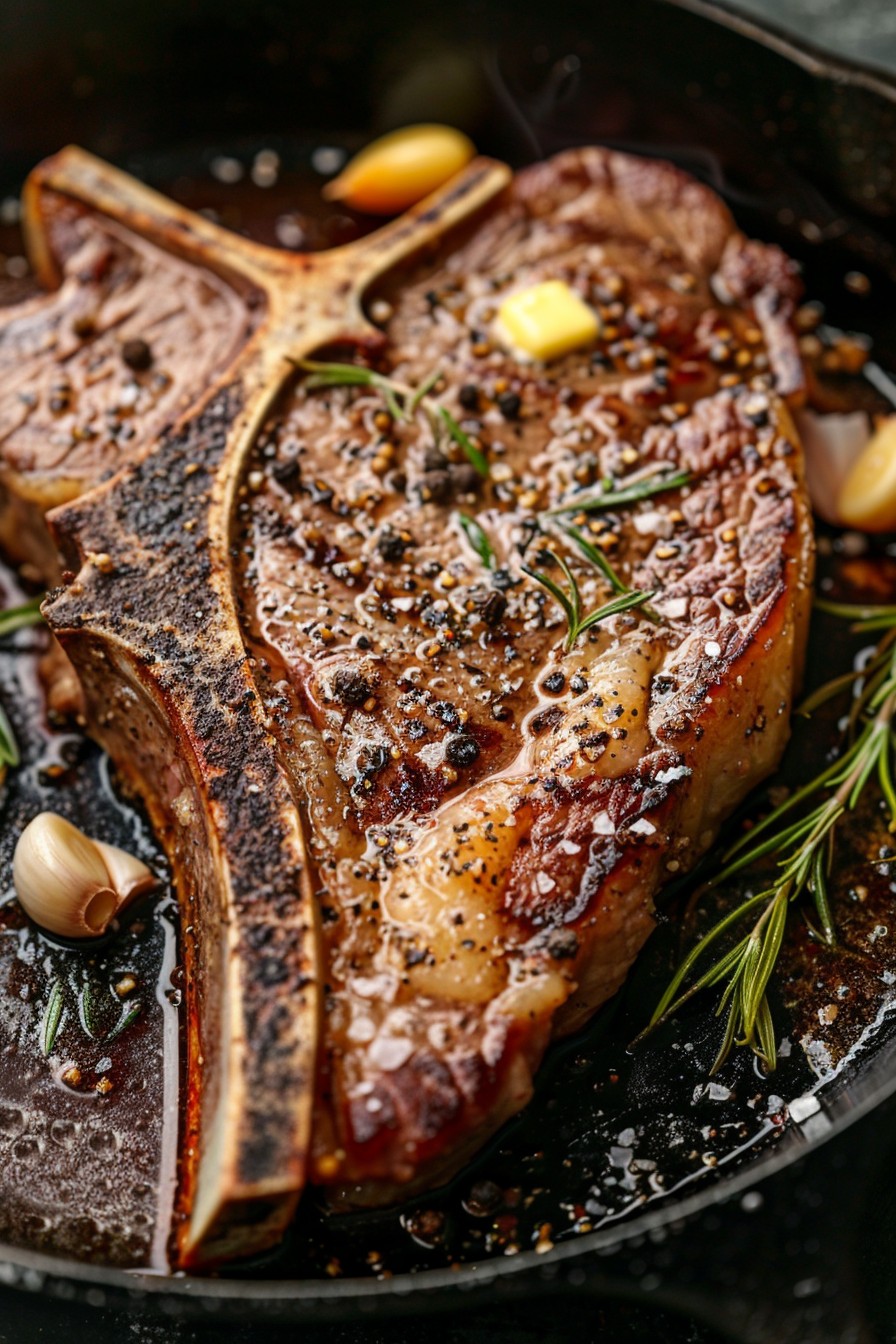Luscious, juicy, and packed with flavor, mastering the T-bone steak in a cast iron pan is a game-changer for any home chef. This recipe promises a restaurant-quality meal right from your kitchen, combining simplicity with sophistication for an unforgettable dining experience.
Why This Recipe Works
- The cast iron pan ensures an even, high heat sear, locking in those precious juices.
- Resting the steak after cooking allows the fibers to relax, ensuring every bite is tender.
- A simple seasoning of salt and pepper lets the natural flavors of the beef shine.
- Cooking with butter and aromatics adds depth and richness to the steak’s flavor profile.
- The T-bone offers the best of both worlds: tenderloin on one side and strip steak on the other.
Ingredients
- 1 T-bone steak, about 1.5 inches thick
- 1 tbsp coarse sea salt
- 1 tbsp freshly ground black pepper
- 2 tbsp unsalted butter
- 2 cloves garlic, smashed
- 2 sprigs fresh rosemary
Equipment Needed
- Cast iron skillet
- Tongs
- Meat thermometer
- Cutting board
- Aluminum foil
Instructions

Step 1: Prepare Your Steak
Begin by taking your T-bone steak out of the refrigerator at least 30 minutes before cooking to bring it to room temperature. This ensures even cooking. Pat the steak dry with paper towels to remove any moisture, which is the enemy of a good sear. Generously season both sides of the steak with coarse sea salt and freshly ground black pepper.
Step 2: Heat Your Cast Iron Pan
Place your cast iron skillet over medium-high heat and let it get smoking hot. This is crucial for achieving that perfect crust. A properly heated pan will sear the steak quickly, locking in juices without overcooking the interior.
Step 3: Sear the Steak
Carefully place the steak in the hot skillet. Let it cook undisturbed for about 4 minutes to form a crust. Flip the steak using tongs and sear the other side for another 4 minutes. For a medium-rare finish, aim for an internal temperature of 130°F, checking with a meat thermometer.
Step 4: Add Butter and Aromatics
Reduce the heat to medium and add the butter, garlic, and rosemary to the pan. As the butter melts, tilt the pan slightly and spoon the melted butter over the steak continuously for about 2 minutes. This basting process infuses the steak with incredible flavor.
Step 5: Rest and Serve
Transfer the steak to a cutting board and loosely cover it with aluminum foil. Let it rest for at least 5 minutes. This allows the juices to redistribute throughout the meat, ensuring every slice is moist and flavorful. Slice against the grain and serve immediately.
Tips and Tricks
Choosing the right steak is half the battle. Look for a T-bone with a bright red color and even marbling. The thickness of the steak is also key; 1.5 inches is ideal for achieving a good sear without overcooking. Don’t skip the resting period; it’s essential for a juicy steak. Experiment with different herbs in the butter basting step, like thyme or sage, for variety. Lastly, always use a meat thermometer to avoid guesswork and ensure perfect doneness every time.
Recipe Variations
- Spice it up by adding a pinch of cayenne pepper to the seasoning mix.
- For a smoky flavor, finish the steak with a sprinkle of smoked sea salt.
- Swap out rosemary for fresh thyme or oregano in the butter basting step for a different herbal note.
- Add a splash of red wine to the pan after cooking the steak to make a quick, flavorful sauce.
- For a decadent twist, top the rested steak with a pat of blue cheese butter.
Frequently Asked Questions
Can I use a different cut of steak?
Absolutely! While this recipe is tailored for a T-bone, the method works beautifully with ribeye, New York strip, or filet mignon. Adjust cooking times based on thickness and desired doneness.
How do I know when the steak is done?
The most reliable method is using a meat thermometer. For medium-rare, aim for 130°F; medium, 140°F; and medium-well, 150°F. Remember, the steak will continue to cook slightly while resting.
Can I cook this steak without a cast iron pan?
While a cast iron pan is ideal for its heat retention and even cooking, you can use a heavy-bottomed stainless steel pan in a pinch. Avoid non-stick pans as they can’t withstand the high heat needed for searing.
Summary
This T-bone steak recipe is a testament to the beauty of simplicity, delivering a perfectly seared, juicy, and flavorful steak with minimal ingredients. Perfect for a special occasion or a luxurious weeknight dinner, it’s sure to impress.
